The best alternative for making 3D printed stretchy and elastic parts are flexible filament types. No other filament is able to produce objects that depict rubber-like properties.
But printing with them is a difficult task to accomplish. As these filaments are of varying elasticity, the steps of being taken care of before and after 3D printing parts from them, differ.
Mostly all of the flexible filaments are made from thermoplastic elastomers. They are separated from one another primarily in terms of their shore hardness.
This guide is meant to take you through all the flexible filament types, their general melting point, and printing parameters. We’ll also give you exposure to their advantages and disadvantages with some leads that will be helpful to you while 3D printing them.
But before we start some points to remember about flexible filaments are; they have different elasticities depending on the exact chemical formula used in them.
Apart from showing excellent flexibility, they also depict extraordinary strength and chemical resistance. You can stretch them to an extent and they will retain their original shape without distortion. Having stated so, it’s time now to get started with exploring various flexible filament types.
What Are Flexible Filament Types?
As mentioned above, thermoplastic elastomers are the polymers that show elasticity similar to that of cross-linked rubber. But if you start searching for TPE, you may encounter the term TPU a lot.
Why this happens is? The latter is a subset of the former. In other words, the latter is just one variant of the former. Although this is not the case with all the variants of TPE, with TPU it’s very common. Apart from TPU, there is TPC and TPA. Let’s take a look at all of them in detail.
TPU
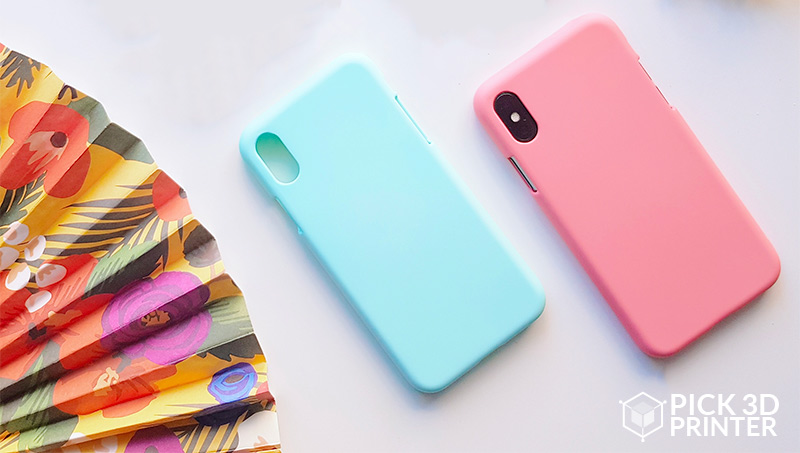
The full form of TPU is Thermoplastic Polyurethane, it is the most common flexible filament type used in 3D printing.
And the reason for such commonality is that it exhibits not just a good amount of flexibility, but also a great amount of rigidity.
Such a property allows it to extrude more easily than other filaments. Other impressive properties of this material are excellent strength and high durability.
Special features of TPU
The material shows a high elastic range typically in the order of 600 to 700 percentages. Depending on the brand you choose, it has shore hardness between 60A to 55D.
It shows excellent printability, is semi-transparent, and has better chemical resistance to oils and greases. Also, TPU has high abrasion resistance.
Things to take care of while 3D printing TPU
The extruder temperature range of your printer should be 210 to 230 degrees Celsius. Its bed temperature range should be anywhere from unheated to 60 degrees Celsius.
The print speed of your printer is recommended to stay as low as 5 millimeters per second to as high as 60 millimeters per second.
For good bed adhesion of TPU, you are advised to use a Kapton’s or a painter’s tape. Your printer’s extrusion should be a direct drive and not a Bowden one. And do not turn on the cooling fan while printing the first few layers.
Challenges and applications
In case the temperature of your extruder is higher than the recommended stringing can occur. Opposite to this, if the temperature is lower than recommended the bed adhesion would be extremely poor. Also, parts made of TPU are known to have poor resistance to UV light.
TPU is industrially used for making shoe insoles, industrial belts, and ski boots. As TPU can handle large shocks and impacts, it is perfect for making vibration damping applications.
TPC
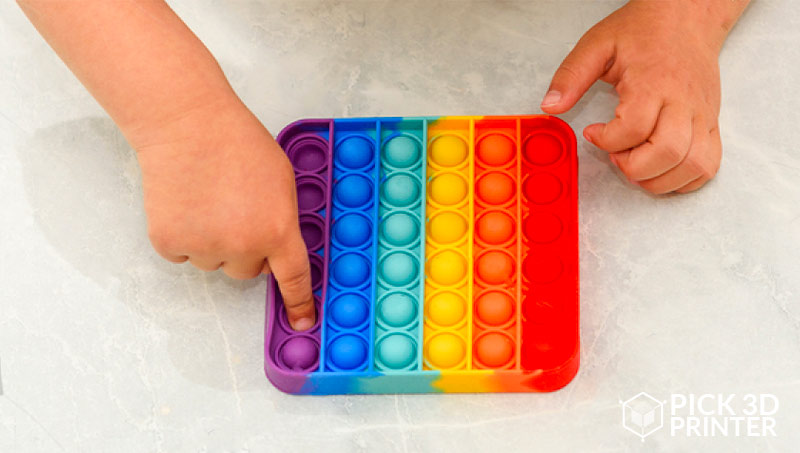
TPC stands for Thermoplastic copolyester. Chemically the material contains copolyether esters with alternating random-length sequences of either long-chain or short-chain glycols.
They have their own hard and soft segments. The former ones are particularly short-chain ester units, whereas the latter ones are generally aliphatic polyethers and polyester glycols.
You would not see many hobbyist 3D printers support TPC as it is an engineering-grade material.
Special features of TPC
The material has low density and elasticity in the order of 350 to 530 percentages. Its shore hardness ranges anywhere between 40 to 72D. TPC shows good chemical resistance and high strength.
It also depicts decent thermal stability and high-temperature resistance. Compared to other flexible filament types, TPC has lower elasticity but is stronger.
Things to take care of while 3D printing TPC
The extruder temperature range while 3D printing TPC should range anywhere from 220 to 260 degrees Celsius whereas the bed temperature range should be around 90 to 110 degrees Celsius.
The recommended print speed range for printing with this filament is 5 to 30 millimeters per second.
Challenges and applications
TPC presents lesser elongation at the break and hence it cannot be used for highly flexible applications. Generally, you will get to see TPC getting employed for making bellows, self-expandable polymer stents, engineering applications such as parts for cars and other kinds of automotive.
PCPTE or TPA
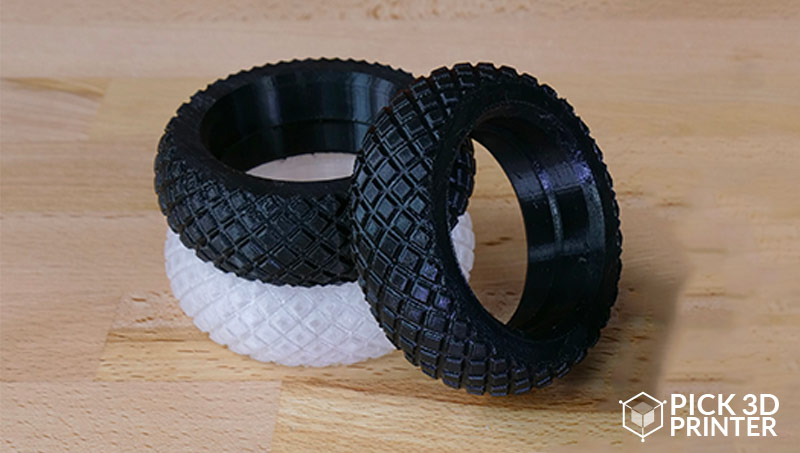
Chemically, Thermoplastic polyamide is a co-polymer of TPE and highly flexible nylon. This flexible filament type gains its flexibility from TPE, smooth and lustrous texture from Nylon.
Special features of PCPTE or TPA
PCPTE or TPA is highly flexible, its elasticity is in the range of 370 to 497 percentages. The shore hardness of this material is between 75A to 63A. It’s exceptionally durable and shows decent printability. TPA has good resistance against heat and layer adhesion. TPA has the capacity to undergo large impacts and high tensile forces without breaking. Owing to Nylon, TPA exhibits enormous strength.
Things to take care of while 3D printing TPA
It is advisable to keep the extruder of your 3D printer in the 220 to 230 degrees Celsius temperature range. Your bed temperature should be around 30 to 60 degrees Celsius, while the print speed can range around standard 5 to 30 millimeters per second.
For achieving a good level of bed adhesion, a PVA-based material is recommended. The employable extrusion system for this flexible filament can be either direct drive or Bowden.
Challenges and applications
TPA is hygroscopic, so you need to store it separately in a box that has a specific set of atmospheric conditions.
If you do not take care while 3D printing TPA, parts and functional prototypes that you print with this material will be subjected to warping commonly.
TPA is generally used for making winter sports material especially skis equipment, golf balls. It is also employed to make medical products such as catheters.
Soft PLA
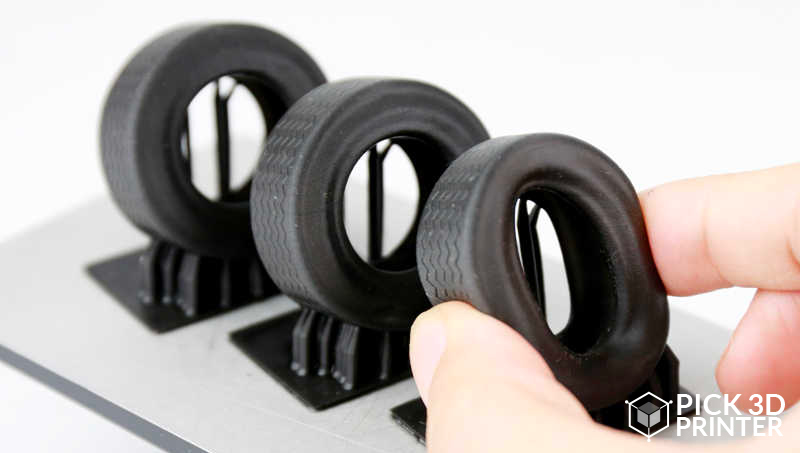
Those brands that purposely keep PLA blends more flexible than usual manufacture soft PLAs. Sometimes, because of the performance, it is able to provide, it’s also referred to an as tough rubber.
Compared to other flexible filament types on the list, soft PLA is known to have more strength and durability. Printing soft PLA and PLA is pretty similar except for the print speed and bed temperature.
Special features of soft PLA
One of the main advantages of Soft PLA over any other 3D printer filament on the list is that it’s biodegradable. Soft PLA has a shore hardness ranging between 90 and 92A.
It has higher strength compared to most others in this list and commendable durability. Some brands of soft PLA are made with a combination of PLA and TPE or TPU.
Those brands are a little less brittle than the usual ones and are also prone to shattering, adding strength and durability to the parts that they manage to produce.
Things to take care of while 3D printing soft PLA
Unlike most other flexible filament types that require a direct drive extrusion system, soft PLA even works with a Bowden system.
The extruder temperature range that’s recommended for 3D printing soft PLA is 220 to 235 degrees Celsius. Whereas the print bed temperature should be at 100 degrees Celsius sharp.
The print speed range for printing soft PLA can be in the range of 10 to 30 millimeters per second.
Challenges and applications
Because of the softness in this material, it is often prone to general problems that other filaments go through while being loaded to the filament spool holder. Soft PLAs are used for making stoppers, springs, and belts.
How To Succeed When 3D Printing Flexible Filament?
Because of their eccentric flexibility, for 3D printing these filaments there are certain parameters that you should keep in mind. They are as follows.
- The first rule is to print slower than usual. Printing faster than 30 millimeters per second can cause kinking or jamming.
- Keep minimum or completely zero retraction for avoiding any random jerky movements which can lead to damaging your filament.
- Lack of retraction can lead to stringing; however, it can be minimized with good print settings.
- Before starting to print, ensure that the filaments are dried. Do not leave the pack of open filament in normal atmospheric conditions. Always store it in dry places, preferably in airtight conditions.
- Direct drive extrusion systems are recommended. But, some filaments can also be printed using Bowden extruders. The main thing to ensure is your printer’s extruder is firm and tight from gear to the hot end.
- It is advisable to not have a 3D printer that has a spool holder above its head. Because such a 3D printing condition can lead to an increase in pressure on the filament.
What Are The Advantages And Disadvantages of Printing With Flexible Filaments?
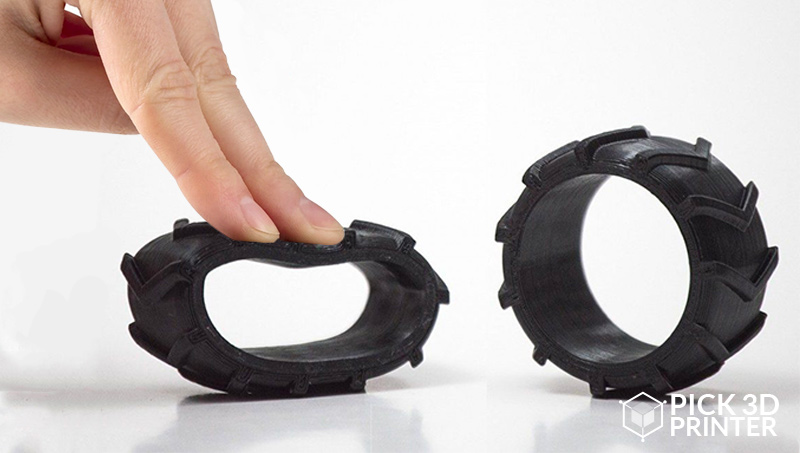
Like every other category of filaments, flexible ones have their own set of pros and cons that are mentioned below.
Advantages:
- The first and foremost benefit that flexible filaments have is that they are flexible. They can be stretched to an extent and they easily tend to return back to the normal shape without any damage. Unlike other filaments, they are not brittle and hence find their use in a wide range of engineering applications.
- Flexible filament types have an excellent range of heat resistance. Not only in handling high temperatures but also in managing with lower ones till -30 degrees Celsius.
- Because of their elasticity, parts printed using flexible filaments can take pretty powerful impacts. For the same reason, you find them getting used in making phone cases and running show midsoles, and vibration dampening.
Disadvantages:
- For ensuring that 3D printed flexible filament parts do not fail because of jamming and clogging, it’s important to print them slowly, between correct temperature ranges and with an accurately calibrated print bed. Doing all of which, consumes a lot of time.
- Most of these filaments are hygroscopic therefore need to be stored inside a proper arrangement.
- Due to the lack of retraction, it is important to optimize your 3D printer’s travel movements. This subjects them to the risk of stringing.
The Conclusion
Printers like Creality Ender 3, Ender 5 Pro, Qidi Tech X-Pro, Flashforge Creator Pro, Pulse XE are known to provide excellent results with flexible filament types. Their construction and arrangement are extremely suitable for rubber-like filaments.
It is to be noted, how the trend of printing with flexible filaments is experiencing rapid growth in recent times.
More and more companies are manufacturing various brands of flexible filaments that exhibit different properties and hence are used for printing parts that can find application in vivid industries.
Before this, FDM 3D printing was only limited to filaments such as ABS, PLA, PETG, PVA, etc.
While buying any of the mentioned flexible filament types, note the general specificities like extruder temperature range, heated bed temperature range, recommended print speeds, and make sure they are compatible with your 3D printer.
Printing with flexible filaments is a bit challenging but if done with the correct amount of care, you get amazing prints.
Parts like electrical casings, phone cases, dampeners, automotive parts, shoes can be precisely and only printed using these sets of filaments.
Overall, flexible filaments have a very unique space in the world of 3D printer filaments not only because they offer what others cannot, but also because it’s hard for beginners to keep up with it.







